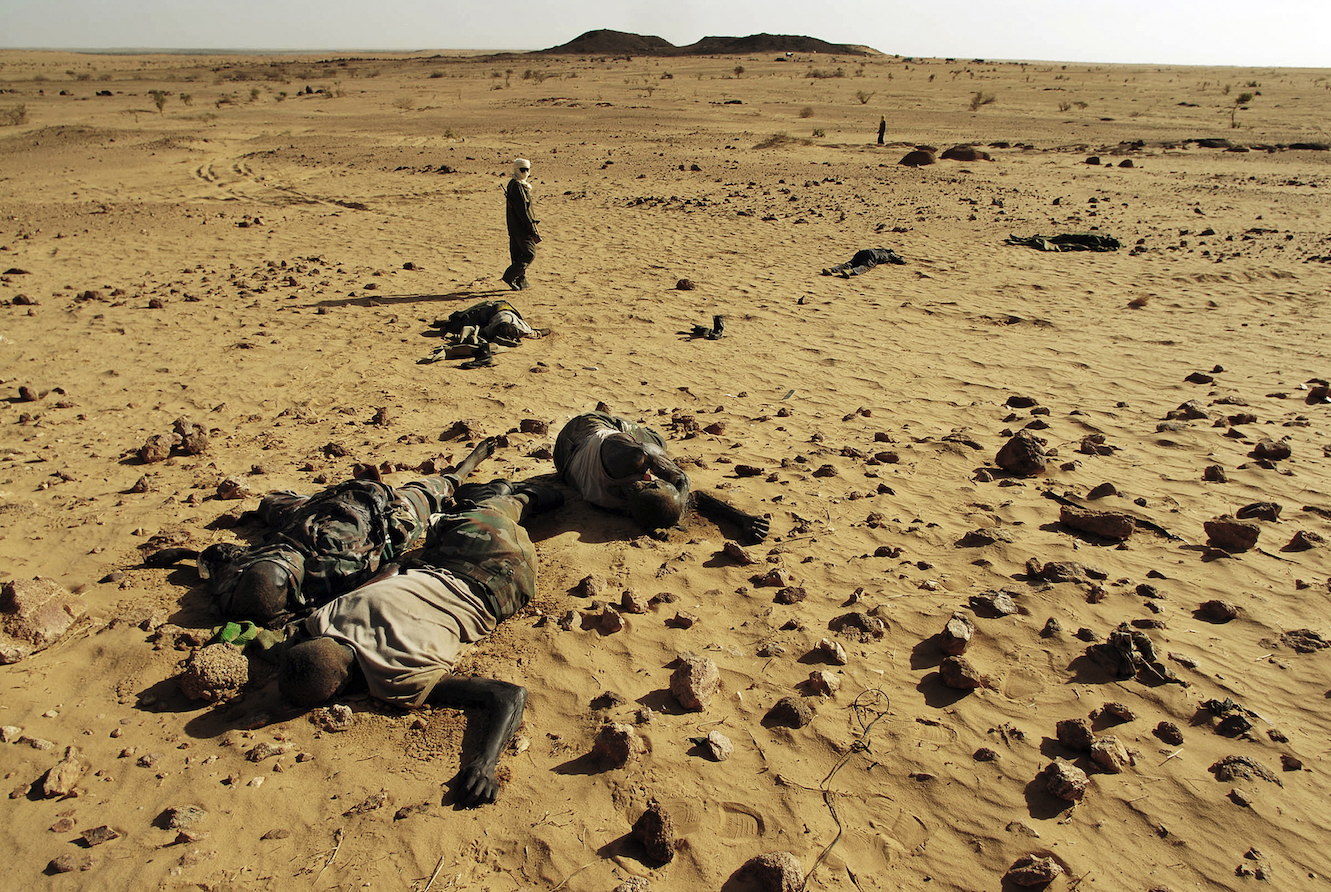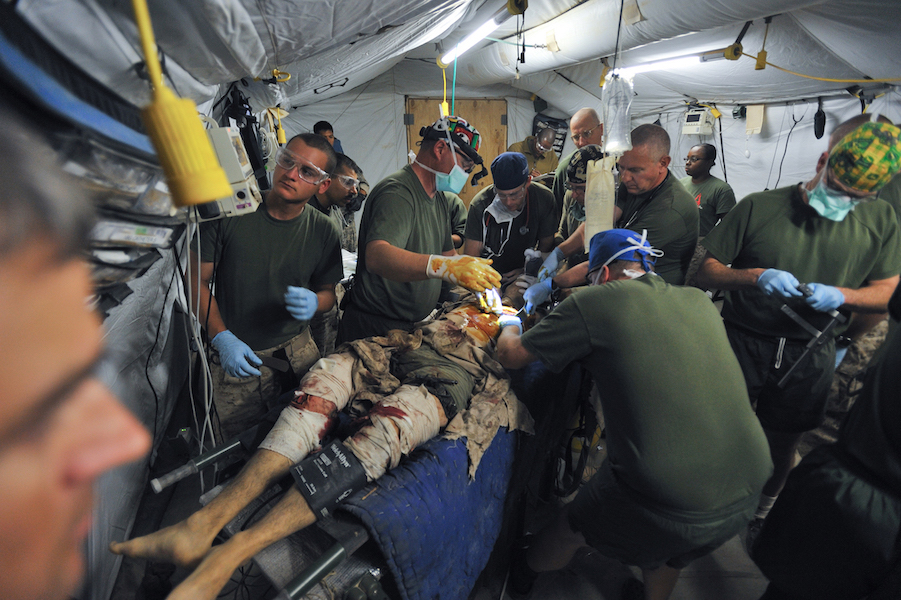On the frontlines with photojournalist Lynsey Addario
- Text by Miss Rosen
- Photography by Lynsey Addario

“Images can sometimes cause a more visceral reaction than words,” says Pulitzer Prize-winning photojournalist Lynsey Addario, who is currently covering the Russian invasion of the Ukraine. “A powerful photograph can bring the viewer into an intimate space in someone’s life within seconds. Images also transcend any language barrier and are a universal way of connecting people.”
Whether on the frontlines of war or standing shoulder to shoulder with women fighting forest fires in the American northwest, Addario has used photography to chronicle global triumph and tragedy since 1996. The new exhibition, The Master Series: Lynsey Addario, brings together over 125 printed works, never-before-seen ephemera, historical records, and audio-visual installations chronicling her singular career.

Khalid, seven, sits outside the medical tent of a US military base after being injured by shrapnel from a bomb dropped by the Americans, Afghanistan, October 2007.

109 African refugees are rescued by the Italian navy from a rubber boat in the sea between Italy and Libya, October 2014.
Armed with only camera, Addario has documented some of the most dangerous conflict zones of the new millennium, including those in Afghanistan, Iraq, Libya, and Syria. “When I am working, I am so focused on telling the stories of the people around me – people who are living amidst war and hardship and who are often the innocent victims of decisions made by people in positions of power – that drive overrides the fear I feel in war zones,” she says.
“I am also constantly surrounded by people living in insecure circumstances with no option to leave, so part of my courage is derived from the people I am photographing. If they can withstand certain conditions, then I must be able to in order to tell their stories.”

Noor Nisa, 18 (right), in labor and stranded with her mother in Badakhshan Province, Afghanistan, November 2009.

Sudanese rebels with the NRF walk past dead Sudanese government soldiers as they walk through a temporary military camp for the GOS near the Darfur Chad border, in Darfur, October 19, 2006.
From the outset of her career, Addario has focused on humanitarian and women’s issues, and aimed to dispel stereotypes and offer new points of view. The Master Series offers an expansive look at Addario’s prolific career (her work has been published in the likes of The New York Times, Time, Newsweek, and National Geographic), providing insight into the conflicts and humanitarian crises that have shaped the world over the past two decades. Addario regularly risks her life to make this work, her sense of purpose and determination fuelled by what she describes as a “belief that photographers bear witness to injustices and the photographs are records of proof of those injustices”.
Addario speaks about photographing the tragic and senseless death of Mamma Sessay, who haemorrhaged after giving birth to twins at a government hospital in Sierra Leone in 2010 because there was no doctor available to treat her. “At that point, more than 550,000 women were dying annually in childbirth, with 60 per cent of those deaths preventable,” Addario says.

Soldiers with the Sudanese People’s Liberation Army, Sudan, August 2004.
Shortly after her death, Time published Addario’s work, which one of the board members from Merck shared at a meeting. The photo essay helped solidify an existing recognition of the need to act. She explains, “The board members made a unanimous decision to start Merck for Mothers and put $500 million toward fighting maternal death worldwide.”
Addario understands the importance of family to sustain us through the challenges we face. “My husband and two children are an incredible source of love that enable me to keep going back out in the field when I sometimes feel defeated or heartbroken by all I witness,” she says. “And I can never overstate how much my parents and sisters provide me with a constant source of strength and inspiration that also keep me going.”

US Navy doctors in Southern Afghanistan try to save the life of Lance Cpl. Jonathan A Taylor, 22, of Jacksonville, Fla., 2009.

Pakistani Taliban fighters jump out of a truck in Bar Kambar Khei, July 2008.

Sgt. Tanner giving water to specialist Carl Vanderberge, Oct 2007.
The Masters Series: Lynsey Addario is through 10 December 2022 at SVA Chelsea Gallery.
Enjoyed this article? Like Huck on Facebook or follow us on Twitter.
You might like

Remembering New York’s ’90s gay scene via its vibrant nightclub flyers
Getting In — After coming out in his 20s, David Kennerley became a fixture on the city’s queer scene, while pocketing invites that he picked up along the way. His latest book dives into his rich archive.
Written by: Miss Rosen

On Alexander Skarsgård’s trousers, The Rehearsal, and the importance of weirdos
Freaks and Finances — In the May edition of our monthly culture newsletter, columnist Emma Garland reflects on the Swedish actor’s Cannes look, Nathan Fielder’s wild ambition, and Jafaican.
Written by: Emma Garland

Dalia Al-Dujaili: “When you’re placeless, nature can fill the void”
Babylon, Albion — As her new book publishes, the British-Iraqi author speaks about connecting with the land as a second-generation migrant, plants as symbols of resistance, and being proud of her parents.
Written by: Zahra Onsori

Why Katy Perry’s space flight was one giant flop for mankind
Galactic girlbossing — In a widely-panned, 11-minute trip to the edge of the earth’s atmosphere, the ‘Women’s World’ singer joined an all-female space crew in an expensive vanity advert for Jeff Bezos’ Blue Origin. Newsletter columnist Emma Garland explains its apocalypse indicating signs.
Written by: Emma Garland

Katie Goh: “I want people to engage with the politics of oranges”
Foreign Fruit — In her new book, the Edinburgh-based writer traces her personal history through the citrus fruit’s global spread, from a village in China to Californian groves. Angela Hui caught up with her to find out more.
Written by: Angela Hui

We are all Mia Khalifa
How humour, therapy and community help Huck's latest cover star control her narrative.
Written by: Alya Mooro